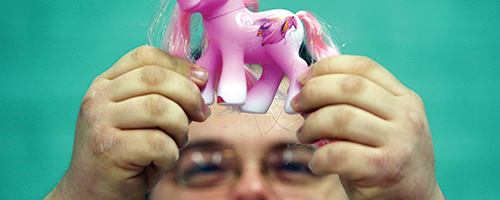For the past few decades, many subcultures have bewildered the general public (goths, emos and hippies, to name just a few). And while these groups may have been misunderstood in their time, their members bonded as one and basked in their own invented way of life.
That’s my brony
[portfolio_slideshow id=50442]
For the past few decades, many subcultures have bewildered the general public (goths, emos and hippies, to name just a few). And while these groups may have been misunderstood in their time, their members bonded as one and basked in their own invented way of life.
Today, their contributions to the world at large are historic reminders that black lipstick, hair that covers 95 percent of your face and hemp underwear are all bad ideas. However, society has for the most part learned to accept them and has even incorporated some of the less bizarre aspects of their respective communities into the American mainstream.
So am I saying that bronies, the 21st-century example of subcultural eccentricity in America, will someday be accepted by renowned fashion labels—that models will walk down runways with pink plush ponies in tow? Hey, stranger things have happened.
The term “brony” refers to an adult fan of the children’s TV show My Little Pony: Friendship is Magic. The program, if you haven’t guessed by its title, is drawn in an extremely prismatic style, with wide-eyed, multicolored ponies sporting names like Pinkie Pie, Rainbow Dash and Twilight Sparkle bouncing around and singing catchy parables about sharing, caring and, of course, friendship.
You may have heard of the trademarked brand My Little Pony, started by Hasbro in the early 1980s. The line of toys developed into a massive enterprise, with feature-length films, TV specials and an insane amount of merchandise.
The target audience has always been little girls, but for some reason the newest animated incarnation has grabbed the attention of a large demographic of adults—namely, adult men.
It began, as many 21st-century subcultures do, on the Internet. The popularity of the movement began to grow steadily around 2010, and by 2011 there was already a My Little Pony convention scheduled: BronyCon.
The first BronyCon, held in New York, drew a crowd of about 100, and it grew exponentially from there. The most recent BronyCon, held in New Jersey last summer, attracted well over 4,000 fans, while the next event, scheduled for August at the Baltimore Convention Center, is estimated to bring in twice that number. There’s even a Portland State club dedicated to the show.
Undoubtedly there is a stigma attached to following the cutesy, innocuous adventures of ponies, and it is one that calls into question the maturity level of an adult who actively fixates on a children’s cartoon show. Those curious about bronies are typically introduced to their unique brand of fandom via YouTube, which may not be the best way to get acquainted with them.
The most-viewed videos of bronies often feature sing-alongs of the TV show’s theme song in public places (e.g. McDonald’s) or a devious non-brony with a microphone interviewing shy, awkward fans. A personal favorite of mine features a fan ranting over the incongruity of a My Little Pony coloring book and the TV show’s backstory, seemingly unaware that adults should probably not be spending their time combing over the details of a coloring book created for children and infants.
Yet it is unfair to generalize the brony culture as a haven for man-children simply based on what one finds in the deep, dark recesses of YouTube. Like the goths of the ’80s, bronies form a subset of individuals who share a common interest, or at least identify with a subject that suits their personalities. Like the characters on the show, the fad they’re celebrating is harmless. And at the rate the group’s popularity is growing, many more of us may be sporting Pinkie Pie tattoos in the very near future.






